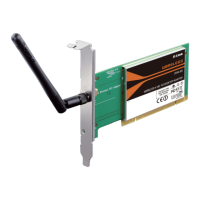
Do you have a question about the D-Link DWA-525 and is the answer not in the manual?
| operating temperature | 32°F to 104°F (0°C to 40°C) |
|---|---|
| operating humidity | 10% to 90% maximum (non-condensing) |
| frequency range | 2.4GHz to 2.483GHz |
| device dimensions | 65x40x5mm |
|---|---|
| standard bracket weight | 40.5g |
| short bracket weight | 35.5g |
Lists items included in the product package.
Specifies the hardware and software needed for the adapter.
Provides an overview of the DWA-525 adapter's purpose and benefits.
Details the key capabilities and advantages of the DWA-525 adapter.
Describes physical components and the function of the LED indicator.
Initial steps before installation, including checking prerequisites.
Instructions for uninstalling previous wireless adapter software.
Guide to disabling other wireless adapters to avoid conflicts.
Tips for optimal placement and performance of the wireless adapter.
Step-by-step guide to physically install the PCI adapter.
Connecting via Push Button (WPS) and Manual SSID/Password entry.
Overview and use of the D-Link utility for managing the adapter.
Guide to connecting using Wi-Fi Protected Setup (PBC and PIN methods).
Creating, editing, and activating wireless network profiles.
Instructions for connecting using Windows 7, Vista, and XP utilities.
Accessing support and about information within the utility.
Explains WEP and WPA/WPA2 security standards.
Steps to set up WEP security using D-Link utility and Windows utilities.
Steps to set up WPA/WPA2 security using D-Link, Windows 7, Vista, and XP.
Advanced setup for WPA/WPA2 with a RADIUS server.
Steps to confirm the wireless adapter is installed correctly.
Resolving connection failures, LED indicator problems, and forgotten keys.
Addressing adapter recognition and network/internet connection failures.
Addressing problems related to wireless signal range and distance.
Explains wireless concepts, WLAN, WPAN, and D-Link's role.
Provides advice on centralizing routers and eliminating interference.
Explains the two main networking modes: Infrastructure and Ad-Hoc.
Steps to verify the adapter's IP address using ipconfig.
Guide to manually setting IP address, subnet mask, and gateway.